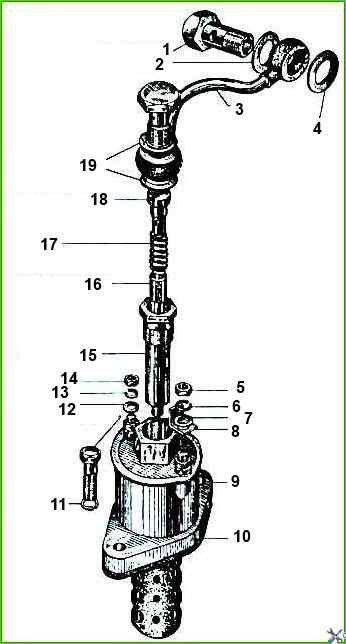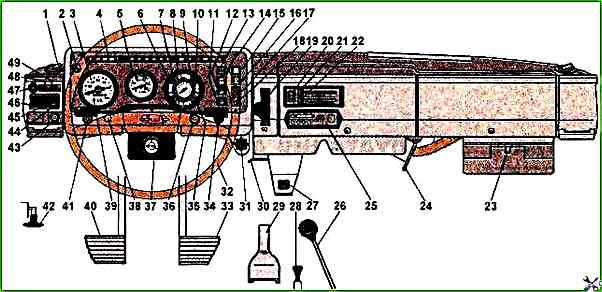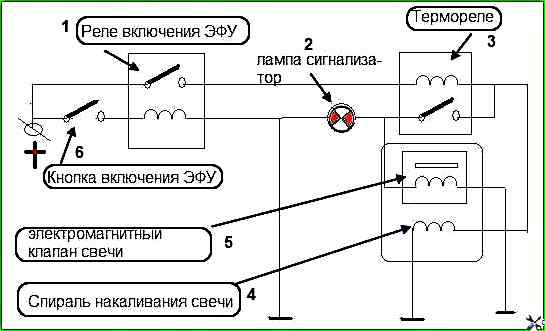Starting a cold engine using the ZIL-5301 electric torch device
The electric torch device (ETD) is designed to facilitate starting a cold engine at an ambient temperature below minus 5°C
The EFD is effective at ambient temperatures down to minus 22°C; at lower temperatures, a pre-heater should be used.
The EFD operates by heating the air entering the engine cylinders with a spark plug torch.

The fuel supplied to the spark plug does not burn completely.
The unburned part of it in the form of vapors and heated gas enters the cylinders, contributing to the occurrence of additional ignition sources in the combustion chamber.
The current consumed by the EFU does not have a negative effect on the subsequent starter discharge of the batteries.
At the same time, the current consumed by the starter decreases by 4-6 times, due to earlier flashes in the engine cylinders.
When the EFU button is turned on, the voltage from the batteries through the EFU switching relay and the thermal relay is supplied to the torch spark plug.
Simultaneously with the spark plug heating up, the thermal relay heats up and is triggered, turning on the electromagnetic valve and the signaling device in the block signaling devices.
The valve opens and fuel flows to the spark plug, and the signaling device lights up to indicate that the device is ready to start the engine.
In addition, when the EFU button is turned on, voltage is supplied to the relay, which breaks the generator excitation winding circuit, which is necessary to protect the spark plugs from the voltage generated by the generator when the engine reaches a stable mode accompanied by the EFU operation.
Maintaining the flame at a low engine crankshaft speed after starting helps it quickly reach an independent operating mode and reduce the smoke that occurs in an unheated engine.
The resistance of the thermal relay coil is selected so that a voltage of 19 V (nominal spark plug voltage) is provided at the spark plug terminals.
To start a cold engine using an EFU, the following is required:
- 1. Bleed the engine fuel system with a manual fuel priming pump.
- 2. Make sure there is fuel in the EFU tank.
- 3. Set the engine stop handle to the operating position and the gearbox lever to neutral.
- 4. Turn on the battery.
- 5. Set the manual fuel feed traction handle to the middle position, having first pressed the fuel feed pedal.
- 6. Turn on the instruments.

- 7. Press button 36 (see Fig. 2) of the EFU switch and hold it until the indicator lights up.
- Indicator 12 (see Fig. 3) should light up approximately 40-120 sec after pressing the switch button.

- 8. After the indicator lights up, press the fuel pedal and clutch pedal,
Turn the starter switch key to the non-locked position (i.e. turn on the starter) without releasing the switch button.
As soon as the engine starts running, release the starter switch key and hold the EFU switch button until the engine runs steadily, but no more than 1 minute.
If the engine does not start, repeat the above steps after 1-2 minutes.
Diesel fuel must be poured into the EFU tank in accordance with the season. It is strictly prohibited to pour gasoline into the tank.
Main faults of the electric torch device that occur during vehicle operation
Signs of failure of the electric torch device:
- - the current indicator needle goes off scale;
- - the current indicator needle does not move;
- - the current indicator needle shows half the discharge current; no flame.
The most typical failures include:
- - short circuit of the spark plug to the housing ("ground");
- - short circuit or burnout of the thermal relay coil;
- - burnout of the spark plug or lack of contact in the circuit;
- - failure of the fuel system. As a result of the failure, the device does not work in the engine intake manifold or does not work during starter operation.
To check the circuit for an open circuit, connect a test lamp between the spark plug terminal and the engine body. If the circuit is in good condition and the button is pressed, the lamp should light.
If the lamp does not light, check the entire power supply circuit of the spark plug, starting from the batteries.
Check the pushbutton switch by connecting its terminals together with a conductor.
If the EFU works when its terminals are connected, but does not work without a conductor when pressing the button, then the button is faulty.
The serviceability of the EFU switch is also checked with a test lamp by alternately connecting it to the terminals of the button.
Scheme of operation of the electric torch device
Many car enthusiasts ask for a glow plug connection diagram. Therefore, I present the diagram.

When the EFU button is turned on, voltage from the batteries is supplied to the spark plug via the EFU on/off relay and the thermal relay.
At the same time as the spark plug heats up, the thermal relay heats up and is triggered, turning on the electromagnetic valve and the indicator in the indicator block.
The valve opens and fuel flows to the spark plug, and the indicator lights up to indicate that the device is ready to start the engine
Of course, the generator excitation winding blocking relay is also turned on in the car.
But as many people guess, this relay is connected in parallel to the EFU on/off relay.





